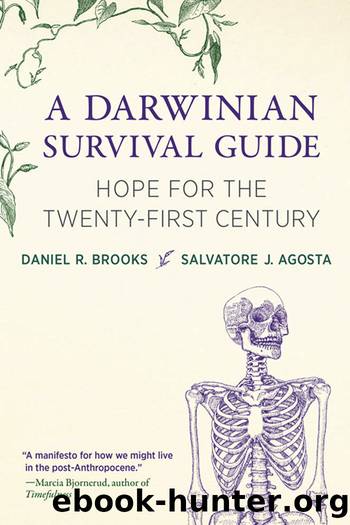A Darwinian Survival Guide by Daniel R. Brooks & Salvatore Agosta

Author:Daniel R. Brooks & Salvatore Agosta [Brooks, Daniel & Agosta, Salvatore]
Language: eng
Format: epub
Publisher: MIT Press
Published: 2024-01-17T00:00:00+00:00
Conservation Biology and the Four Laws
Conservation biology traces its roots from the writings of Alexander von Humboldt at the end of the eighteenth century to twentieth-century classics such as Aldo Leopoldâs 1949 Sand County Almanac. It emerged as a distinct field of study in the 1970s and has become the primary arena for discussions about how to deal with the biodiversity crisis in a period of global climate change. Which species or places should be protected? What size and shape should protected areas be? What kind of protection should be provided? How should protected areas be managed? How should the surrounding communities interact with protected areas? These are the kinds of questions conservation biology has concerned itself with ever since Elton sounded the alarm about biodiversity and climate change in his classic book The Ecology of Invasions by Animals and Plants in 1958.
From the beginning, mainstream conservation biologyâs approach to protecting and managing biodiversity has involved three common non-Darwinian beliefs that are related and deeply ingrained within its thinking. The first is the idea that nature is fragile. As we noted previously, this view was made explicit by Ratcliffe in 1971, during conservation biologyâs infancy, in a paper titled âCriteria for the Selection of Nature Reserves.â In it, Ratcliffe introduced âfragilityâ as a way of measuring how sensitive places or ecosystems were to perturbations as well as a specific criterion for making conservation decisions. Though not all ascribed to the concept of fragility or its usefulness, Ratcliffe inspired others to incorporate it into their way of thinking about the conservation problem. From there, the idea grew into a classic rallying cry for the conservation movement: we must protect nature because it is fragile, where any change can cause the destruction of its delicate balance.
But nature is not fragile. It is robust because it copes with change by changing. The notion of a delicately balanced nature is antithetical to an evolutionary system. In evolution, change is the fundamental mechanism that allows living systems to persist. The biosphere is dynamic, not static, and resilient, not brittle. Most biologists readily accept this, recognizing that any appearance of stasis in nature is an illusion. Still, the message seems to have been missed by much of conservation biology, including researchers and policy makers, and the public, which looks to conservation biology for insight and understanding. This is exemplified by two misconceptions that permeate conservation efforts. The Gaia hypothesis represents the idea that the biosphere acts as a set of coordinated subsystems working to maintain a system-level homeostasisâthat mythical balance of nature. This reinforces the idea that without human interference, the biosphere would somehow exist in a timeless, unchanging state of perfection. From this emerges such nonevolutionary ideas as âreturning nature to the way it wasââthe rewilding of the planet typically inspired by a nostalgia for idyllic nature in a past state of âperfect balanceâ that never actually existed. The butterfly effect is another popular metaphor for describing the state of the biosphere. It rests on
Download
This site does not store any files on its server. We only index and link to content provided by other sites. Please contact the content providers to delete copyright contents if any and email us, we'll remove relevant links or contents immediately.
What's Done in Darkness by Kayla Perrin(26789)
The Ultimate Python Exercise Book: 700 Practical Exercises for Beginners with Quiz Questions by Copy(20641)
De Souza H. Master the Age of Artificial Intelligences. The Basic Guide...2024 by Unknown(20431)
D:\Jan\FTP\HOL\Work\Alien Breed - Tower Assault CD32 Alien Breed II - The Horror Continues Manual 1.jpg by PDFCreator(20413)
The Fifty Shades Trilogy & Grey by E L James(19262)
Shot Through the Heart: DI Grace Fisher 2 by Isabelle Grey(19237)
Shot Through the Heart by Mercy Celeste(19101)
Wolf & Parchment: New Theory Spice & Wolf, Vol. 10 by Isuna Hasekura and Jyuu Ayakura(17273)
Python GUI Applications using PyQt5 : The hands-on guide to build apps with Python by Verdugo Leire(17216)
Peren F. Statistics for Business and Economics...Essential Formulas 3ed 2025 by Unknown(17058)
Wolf & Parchment: New Theory Spice & Wolf, Vol. 03 by Isuna Hasekura and Jyuu Ayakura & Jyuu Ayakura(16977)
Wolf & Parchment: New Theory Spice & Wolf, Vol. 01 by Isuna Hasekura and Jyuu Ayakura & Jyuu Ayakura(16603)
The Subtle Art of Not Giving a F*ck by Mark Manson(14577)
The 3rd Cycle of the Betrayed Series Collection: Extremely Controversial Historical Thrillers (Betrayed Series Boxed set) by McCray Carolyn(14297)
Stepbrother Stories 2 - 21 Taboo Story Collection (Brother Sister Stepbrother Stepsister Taboo Pseudo Incest Family Virgin Creampie Pregnant Forced Pregnancy Breeding) by Roxi Harding(13947)
Scorched Earth by Nick Kyme(12937)
Drei Generationen auf dem Jakobsweg by Stein Pia(11130)
Suna by Ziefle Pia(11054)
Scythe by Neal Shusterman(10527)
